A Fun Day Out Discovering Kamakura
In the heart of Kamakura, where the ancient meets the contemporary, lies a treasure trove waiting to be uncovered.
As visitors meander through its winding streets and hidden alleys, they will discover a world where history whispers through the rustling leaves of sacred temples and the crashing waves of the nearby shore.
But what truly awaits those who venture into this cultural haven?
Just The Basics
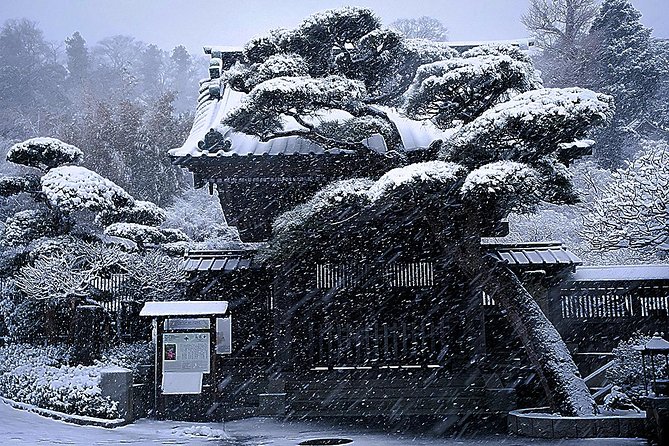
- Explore ancient shrines and temples, like Tsurugaoka Hachimangu and Hase-dera, for a deep dive into Kamakura’s cultural heritage.
- Marvel at architectural wonders such as the majestic Torii gate and the awe-inspiring Great Buddha of Kamakura.
- Immerse in the vibrant local culture on Komachi Street with its array of traditional shops, boutiques, and local delicacies.
- Set out on a rich historical journey through Kamakura’s landmarks and hidden gems for an enriching day trip or weekend escapade.
Getting to Kamakura
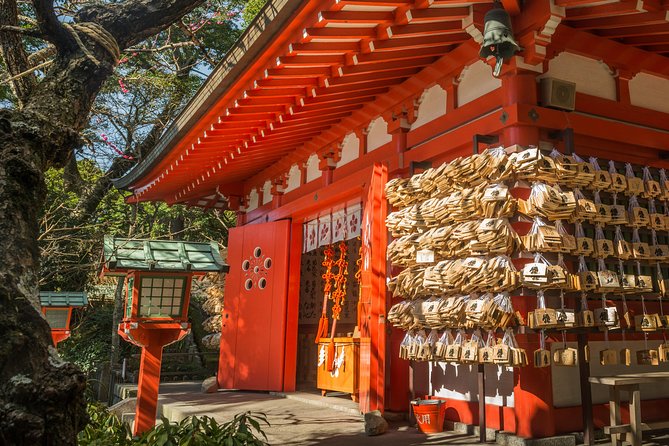
To reach Kamakura, travelers can conveniently take a direct train from Tokyo Station, which typically takes around one hour. Public transportation is the most popular choice due to its efficiency and cost-effectiveness. While car rental is an option, navigating the narrow streets and limited parking can be challenging for visitors.
Upon arriving in Kamakura, travelers will find themselves surrounded by a blend of local landmarks and hidden gems waiting to be explored. From the iconic Great Buddha to the serene Hokokuji Temple, there’s no shortage of culturally rich sites to visit.
Strolling through the quaint streets, visitors can stumble upon charming cafes, boutique shops, and traditional Japanese gardens, adding to the allure of this historic city.
Exploring Tsurugaoka Hachimangu Shrine
Upon entering Tsurugaoka Hachimangu Shrine, visitors are greeted by a majestic Torii gate marking the transition into a spiritual and historical oasis within Kamakura.
The shrine, with its rich history dating back to the 11th century, holds immense cultural significance as one of the most important Shinto shrines in Japan.
Tsurugaoka Hachimangu Shrine was originally established by Minamoto Yoriyoshi and later expanded by Minamoto Yoritomo, the founder of the Kamakura Shogunate. It serves as a symbol of the city’s samurai heritage and is a place where visitors can enjoy traditional Japanese architecture and rituals.
The shrine’s tranquil surroundings and beautiful structures offer a glimpse into Japan’s past and its enduring spiritual traditions.
Enjoying Hase-dera Temple
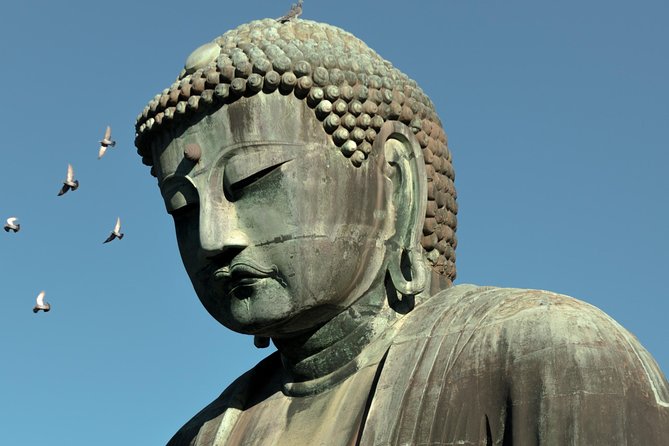
Visitors to Kamakura can further explore the city’s cultural and spiritual heritage by experiencing the serene beauty of Hase-dera Temple. Nestled amidst lush greenery, this temple offers a peaceful retreat where visitors can explore Buddhist history and admire the intricate gardens.
- Strolling through vibrant flower gardens
- Discovering ancient Buddhist statues
- Listening to the soothing sounds of cascading waterfalls
- Marveling at the breathtaking views of the city and ocean
- Reflecting in tranquil meditation spots
Hase-dera Temple provides a harmonious blend of natural beauty and historical significance, making it a must-visit destination for those seeking a deeper understanding of Kamakura’s rich cultural tapestry.
Admiring the Great Buddha of Kamakura

Nestled serenely amidst Kamakura’s historic landscape stands the iconic Great Buddha, a symbol of cultural reverence and historical significance. The Great Buddha of Kamakura, also known as Daibutsu, has a rich Buddha history dating back to the 13th century when it was originally housed in a temple. This massive bronze sculpture, standing at over 40 feet tall, captivates visitors with its serene expression and intricate craftsmanship. The sculpture details include the folds of the Buddha’s robe, the meditative pose, and the serene facial features, all of which add to the aura of tranquility surrounding the statue. Below is a table highlighting key facts about the Great Buddha of Kamakura:
| Aspect | Details |
|---|---|
| Height | Over 40 feet tall |
| Material | Bronze |
| Origin | Cast in 1252, originally housed in a temple |
Strolling Through Komachi Street
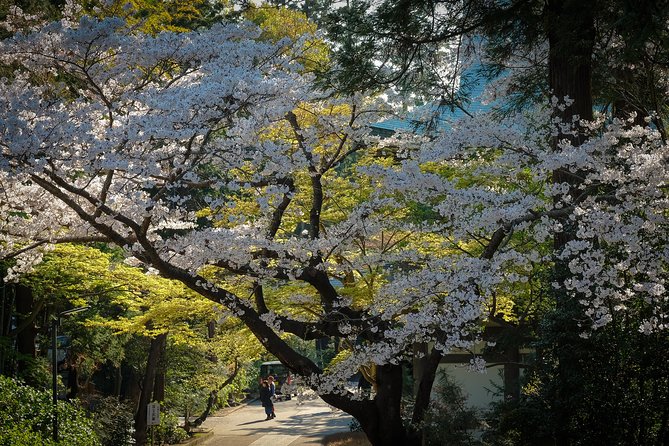
Wandering through Komachi Street offers a glimpse into the vibrant local culture of Kamakura. The narrow pedestrian street is lined with traditional shops and modern boutiques, creating a unique blend of old and new.
Visitors can enjoy the bustling atmosphere while exploring boutiques selling a variety of handmade crafts and souvenirs. The aroma of freshly prepared local snacks wafts through the air, tempting passersby to stop and indulge in traditional treats.
The colorful displays of sweets and savory delights add to the lively ambience of the street, inviting travelers to try local snacks unique to Kamakura. Strolling along Komachi Street is a sensory experience that captures the essence of this charming coastal town.
- Handmade crafts
- Traditional souvenirs
- Aroma of local snacks
- Colorful displays of sweets
- Lively atmosphere
Sampling Local Kamakura Cuisine
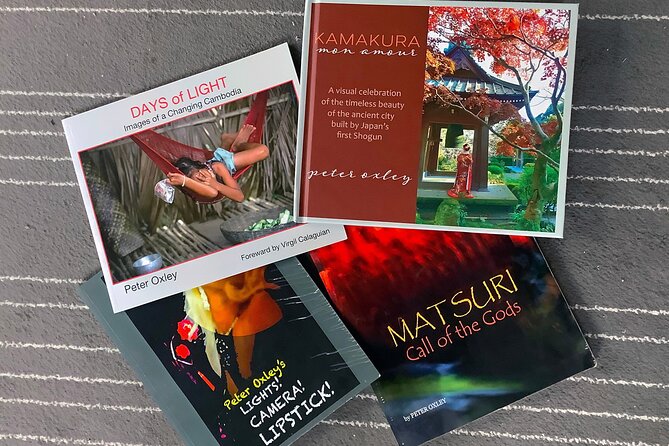
Indulging in the diverse flavors of Kamakura reveals a culinary tapestry woven with local specialties and traditional delicacies. From savory seafood dishes to delicate sweets, visitors can enjoy the rich tapestry of Kamakura’s culinary delights.
Local flavors like shirasu-don (rice bowl with baby sardines) and sweet potato treats offer a unique gastronomic experience that captures the essence of the region. Strolling down Komachi Street provides ample opportunities to sample freshly prepared snacks and beverages, showcasing the vibrant food culture of the area.
Whether savoring grilled seafood skewers or trying matcha-flavored desserts, every bite tells a story of Kamakura’s history and traditions, making it a must-visit destination for foodies seeking authentic Japanese cuisine.
Relaxing at Yuigahama Beach
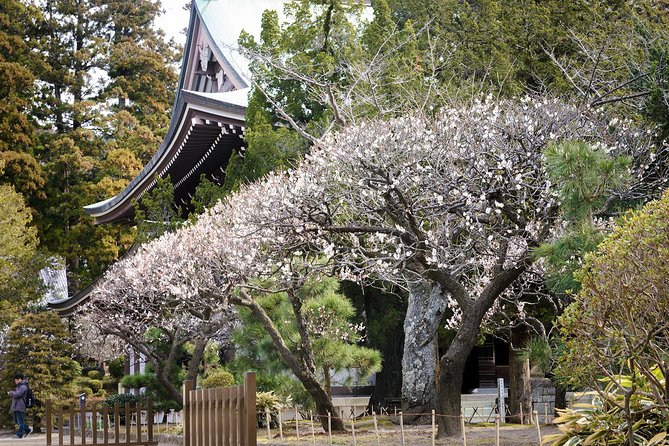
Visitors can unwind and enjoy the serene atmosphere at Yuigahama Beach after exploring the diverse culinary offerings of Kamakura. The beach offers a perfect setting for relaxation, with soft golden sands and gentle waves.
Here are some activities to enjoy at Yuigahama Beach:
- Lounging under colorful umbrellas
- Feeling the warm sun on your skin
- Listening to the soothing sounds of the ocean
- Watching surfers ride the waves
- Taking surfing lessons to experience the thrill firsthand
Whether you prefer to bask in the sun or try your hand at surfing, Yuigahama Beach provides a tranquil escape for visitors to unwind and soak in the beauty of Kamakura’s coastal charm.
Souvenir Shopping in Kamakura

Shops in Kamakura offer a diverse array of unique souvenirs for travelers to explore. Visitors can find a range of items, from traditional crafts to artisanal goods, perfect for taking home a piece of Kamakura’s charm. Here is a glimpse of what you can discover:
| Souvenir | Description | Price |
|---|---|---|
| Handcrafted Pottery | Beautiful pottery pieces made by local artisans | $25 – $50 |
| Wooden Kokeshi Dolls | Hand-painted traditional wooden dolls | $15 – $30 |
| Matcha Tea Set | Authentic Japanese tea set with delicate designs | $40 – $60 |
| Calligraphy Scrolls | Elegant scrolls with Japanese calligraphy | $30 – $45 |
| Indigo-dyed Fabrics | Vibrant fabrics dyed using traditional techniques | $20 – $35 |
Common questions
What Is the Best Time of Year to Visit Kamakura?
The best time to visit Kamakura is during the spring (March to May) or autumn (September to November) when the weather is pleasant for exploration. Visitors can enjoy cherry blossoms in spring and autumn festivals. Transportation options are efficient for touring.
Are There Any Special Events or Festivals That Visitors Should Be Aware of in Kamakura?
Special events in Kamakura include traditional performances, historical reenactments, and cultural festivals. Visitors can immerse in local traditions during seasonal celebrations. These events provide insight into the rich cultural heritage of Kamakura, enhancing the visitor experience.
Can Visitors Rent Bicycles or Other Modes of Transportation to Explore Kamakura?
Visitors in Kamakura can easily explore the area by renting bicycles or utilizing local transport options. Bicycle rentals offer flexibility and convenience, allowing travelers to efficiently navigate the city and enjoy its many attractions.
Are There Any Hidden Gems or Lesser-Known Attractions in Kamakura That Are Worth Visiting?
There are hidden treasures in Kamakura waiting to be discovered. Travelers can explore off the beaten path adventures, enjoy local eats, and soak in scenic views. These lesser-known attractions offer a unique and enriching experience.
How Can Visitors Learn More About the History and Culture of Kamakura During Their Trip?
Visitors can explore Kamakura’s rich history and culture through historical walking tours and cultural workshops. They can also savor traditional cuisine and interact with local artisans to gain a deeper understanding of this enchanting destination.
Last Words
To sum it up, a day spent exploring Kamakura offers a perfect blend of culture and scenic beauty.
From ancient temples to picturesque beaches, visitors are sure to be captivated by the rich history and vibrant atmosphere of this enchanting city.
With a variety of activities to suit all interests, Kamakura promises a fun and memorable experience for travelers seeking a unique Japanese adventure.